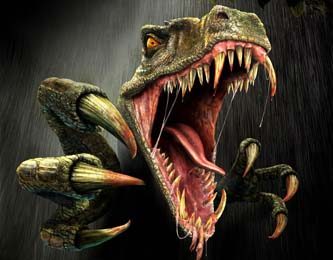What dinosaurs were like deep under the skin
 London, Jan 10: Scientists have been able to get an exceptional glimpse of what dinosaurs were like deep under the skin, thanks to a fossil unearthed in China.
London, Jan 10: Scientists have been able to get an exceptional glimpse of what dinosaurs were like deep under the skin, thanks to a fossil unearthed in China.
The fossil shows that the plant-eating Psittacosaurus had a thick layer of shark-like skin hidden under scales or feathers.
Soft tissues such as skin are seldom conserved in the fossil record, thus leading to intense dispute over what dinosaurs looked like, and whether they were covered in primal feathers or scales.
The Psittacosaurus, or parrot lizard, specimen gives the first thorough depiction of what dinosaurs were like in the flesh.
According to palaeontologists, the tough outer coating supported the dinosaur's organs and protected it from predators.
Tooth marks on the fossil point out that the dinosaur was torn open by a scavenger, giving an exclusive insight into their biology, 100 million years after Psittacosaurus’ death.
The fossil suggests that the bipedal herbivore was gifted with tough, scaly skin with more than 25 layers of collagen.
Experts say that such a skin structure is similar to that of today's sharks, reptiles and dolphins.
"As noted from the studies on modern-day animals, this fibre structure plays a critical part in the stresses and strains the skin may be subjected to and is ideally suited to providing support and protection," BBC quoted Professor Theagarten Lingham-Soliar of the University of KwaZulu-Natal, Durban, South Africa, as saying.
"Psittacosaurus gives a remarkable, unprecedented understanding of the dinosaur skin,” he added.
The fossil sample comes from an area of China that has given away other uniquely-preserved fossils as well.
"Discoveries like this from China are certainly churning out new surprises," Mark Witton of the School of Earth and Environmental Sciences at the University of Portsmouth, UK.
"To have the skin folded on the fossil so that you can see the cross section through it is remarkable,” he added.
Witton further explained that the skin of the dinosaur would have been "incredibly tough" and possibly served to protect the animal from predators.
"We imagine this Psittacosaurus as a tubby little animal walking around on its back legs," he said.
"Psittacosaurus may have been a bit like a prehistoric pig, wandering around woodlands and forests and eating all manner of plants, scavenging the odd carcass and maybe eating the odd little animal here and there,” he added.
The research is published in the Royal Society's journal Proceedings B. (ANI)